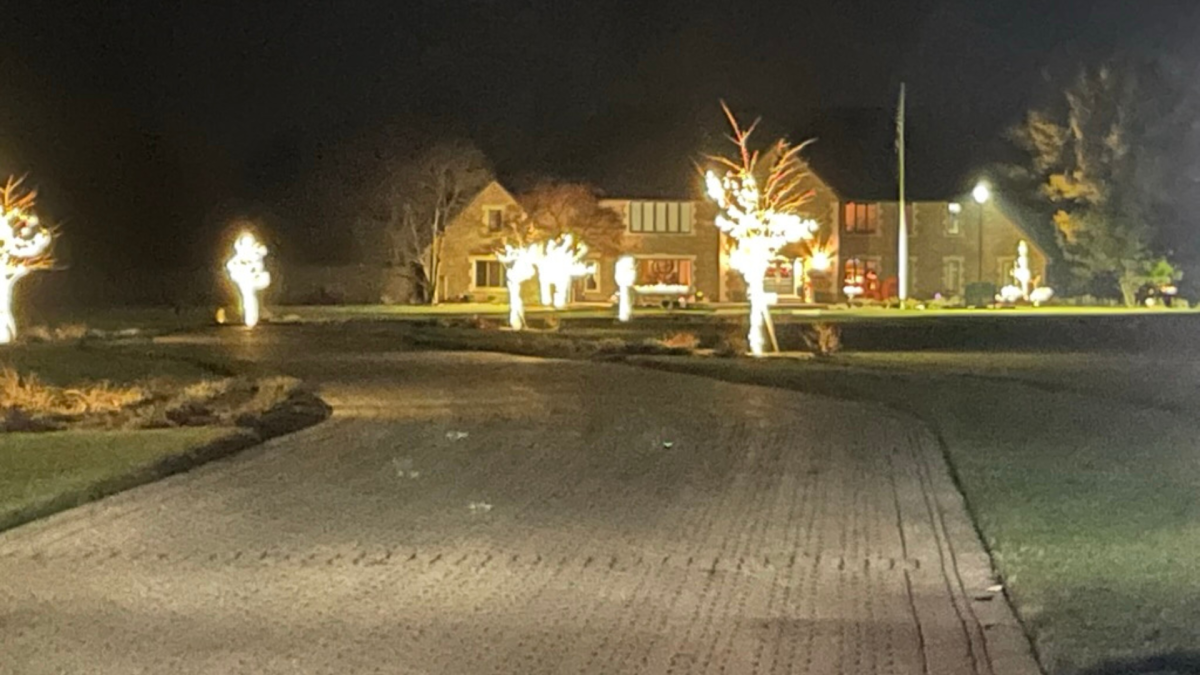Safety considerations have emerged as a primary factor influencing how Toledo area homeowners approach holiday lighting installation. Recent data from the Consumer Product Safety Commission indicates that emergency room visits for ladder-related injuries increase substantially during November and December, with holiday decorating representing a significant contributor to these incidents.
The statistics reveal concerning patterns. Approximately 164,000 Americans receive emergency room treatment annually for injuries involving ladders, with falls from roofs and elevated surfaces during holiday decoration contributing meaningfully to seasonal spikes. For Toledo homeowners, these risks intensify due to regional climate factors including unpredictable weather, icy conditions, and temperature fluctuations that create hazardous working environments during typical installation periods. Understanding comprehensive safety considerations helps property owners make informed decisions that prioritize family wellbeing alongside aesthetic goals.
Documented Risks Associated With DIY Holiday Lighting
Multiple hazard categories affect homeowners attempting independent holiday lighting installations. Height-related risks represent the most obvious danger, but electrical hazards, weather exposure, and property damage potential create additional safety concerns that merit serious consideration.
Ladder accidents account for the majority of holiday decoration injuries. Falls from heights between six and fifteen feet commonly result in fractures, head injuries, and soft tissue damage requiring medical intervention. Severity increases with victim age, making these activities particularly dangerous for homeowners over fifty who comprise a significant portion of Toledo's suburban population.
Contributing factors to ladder accidents include improper equipment selection, incorrect positioning, overreaching while working, uneven ground surfaces, and working alone without assistance. Many homeowners utilize inadequate ladders borrowed from neighbors, aging equipment with structural deterioration, or models inappropriate for required heights. Extension ladder positioning errors particularly along rooflines create unstable conditions that collapse under user weight or shift during work activities.
Weather conditions during typical November installation periods compound fall risks substantially. Morning frost creates slippery roof surfaces and ladder rungs. Wind gusts destabilize elevated positions. Cold temperatures reduce manual dexterity affecting grip strength and fine motor control necessary for secure positioning. These environmental factors transform already risky activities into genuinely dangerous undertakings.
Electrical hazards represent serious though less visible dangers. Improper outdoor extension cord usage, overloaded circuits, damaged light strands, and inadequate ground fault protection create fire and electrocution risks. The National Fire Protection Association reports that electrical failures or malfunctions cause approximately one-quarter of December home fires, with decorative lighting contributing to these incidents.
Specific electrical mistakes include connecting too many light strands end-to-end, using indoor-rated extension cords outdoors, failing to protect connections from moisture exposure, and plugging high-draw lighting into circuits already near capacity. Homeowners lacking electrical knowledge often remain unaware of proper load calculations, wire gauge requirements, or ground fault circuit interrupter necessity for outdoor applications.
Property damage risks extend beyond personal injury concerns. Improper fastening techniques damage gutters, create roof leaks, crack siding, or loosen shingles. Aggressive clip installation along aluminum gutters causes permanent deformation. Staples or nails driven through vinyl siding create moisture entry points that lead to expensive repairs. Weight stress on inadequately supported gutters causes separation from fascia boards.
Professional Safety Protocols and Equipment Standards
Established holiday lighting companies implement comprehensive safety protocols that eliminate or substantially reduce risks inherent in installation activities. These systematic approaches combine proper equipment, trained personnel, and proven procedures developed through thousands of installations.
Commercial ladder systems differ significantly from residential equipment. Professional-grade extension ladders feature wider bases, reinforced construction, higher weight ratings, and stabilizer systems that distribute load safely. Specialized ladder accessories including roof hooks and gutter protection devices prevent surface damage while ensuring secure positioning.
Fall protection equipment represents standard protocol for professional crews working at significant heights. Safety harnesses, anchor systems, and proper tie-off procedures provide redundancy that prevents injuries even if primary positioning fails. This equipment requires training for effective use, explaining why professional installation significantly reduces accident risk compared to DIY approaches.
Team-based installation methods ensure continuous safety oversight. Spotter personnel stabilize ladders, hand materials to elevated workers, and monitor conditions that might create hazards. This collaborative approach prevents the dangerous solo work that characterizes most residential DIY attempts.
Weather monitoring protocols prevent working during unsafe conditions. Professional companies track forecasts closely, rescheduling installations when high winds, precipitation, or icy conditions create elevated risks. This operational flexibility, unavailable to homeowners committed to specific weekend schedules, maintains safety standards throughout seasonal installation periods.
Electrical Safety Expertise and Code Compliance
Professional installers possess electrical knowledge that prevents the circuit overload, connection failures, and fire hazards associated with amateur installations. This expertise encompasses load calculations, proper material selection, code compliance, and weatherproofing techniques.
Circuit capacity assessment determines how much lighting individual circuits can safely support. Professionals calculate total wattage requirements, identify available circuits, and distribute loads appropriately. This prevents breaker trips, voltage drops that damage electronics, and overheating conditions that create fire risks.
Proper extension cord selection considers length, gauge, and outdoor rating requirements. Professional-grade cords feature heavier wire gauges that minimize voltage drop over distance, weatherproof construction that withstands moisture exposure, and grounded plugs that provide essential shock protection. These specifications exceed typical residential extension cord capabilities.
Ground fault circuit interrupter protection represents mandatory safety equipment for outdoor electrical applications. GFCI devices detect current imbalances indicating potential shock hazards and interrupt power within milliseconds. Professional installations ensure all outdoor connections receive this protection, typically through GFCI outlet usage or in-line GFCI devices incorporated into electrical runs.
Connection weatherproofing prevents the moisture intrusion that causes shorts, corrosion, and shock hazards. Professional methods elevate connections above ground level, utilize weatherproof boxes or covers, and apply dielectric grease to contact surfaces. These techniques maintain electrical integrity throughout winter precipitation exposure.
Material Quality and Safety Relationships
Commercial-grade materials used by professional services incorporate safety features absent from consumer products. These quality differences affect both installation safety and ongoing operational risks throughout display periods.
Professional LED lighting systems feature superior insulation, more robust strain reliefs, and weatherproof construction designed for commercial applications. Connection points utilize locking mechanisms that prevent accidental separation. Wire gauges accommodate higher current loads without overheating. These engineering differences reduce failure rates and associated fire risks.
Mounting hardware designed specifically for holiday lighting applications prevents property damage while ensuring secure attachment. Specialized clips accommodate various surface types without requiring penetrations that compromise weather barriers. Proper hardware selection based on mounting surface characteristics prevents the improvised solutions that frequently damage residential properties.
Timer and control systems incorporating safety features provide automated operation that eliminates manual switching. Professional-grade timers include surge protection, backup batteries maintaining programming during power outages, and weatherproof enclosures suitable for outdoor locations. These systems prevent the exposed indoor timers and tangled extension cord arrangements common in DIY installations.
Insurance and Liability Considerations
Professional installation transfers liability for accidents, injuries, and property damage from homeowners to insured contractors. This risk mitigation represents significant financial protection beyond immediate safety advantages.
General liability insurance carried by legitimate contractors covers property damage caused during installation activities. If crews accidentally damage gutters, break windows, or create other property harm, insurance provides repair cost coverage without homeowner expense. Rock Solid Landscape and other established providers maintain substantial coverage limits reflecting their commitment to customer protection.
Workers' compensation insurance protects homeowners from liability if installation personnel suffer injuries on their properties. Without this coverage, property owners potentially face claims for medical expenses, lost wages, and disability benefits. Verifying workers' compensation coverage before allowing work represents essential due diligence.
Regional Climate Factors Affecting Toledo Installations
Northwest Ohio's climate patterns create specific challenges that professional installers address through experience-informed practices. Understanding these regional factors helps explain why professional services deliver superior safety outcomes compared to DIY approaches by homeowners unfamiliar with technical considerations.
Temperature fluctuations between installation and operation periods affect material performance. Professional installers account for thermal expansion and contraction, selecting mounting methods that accommodate dimensional changes without creating stress points. This prevents the loosening and failures that occur when amateur installations ignore thermal dynamics.
Ice accumulation on rooflines and gutters creates weight loads that stress mounting systems. Professional outdoor lighting installation services incorporate load calculations ensuring displays withstand anticipated ice buildup without damaging structures or failing catastrophically.
Wind exposure varies significantly based on property location, surrounding vegetation, and architectural configuration. Experienced installers assess site-specific wind conditions and adjust mounting densities, secure connection points, and select materials appropriate for exposure levels. This customized approach prevents wind damage common with one-size-fits-all DIY methods.
Long-Term Safety Through Maintenance and Monitoring
Professional services extend safety benefits beyond initial installation through midseason monitoring and prompt issue resolution. This ongoing support maintains safe operation throughout display periods.
Weather damage assessment following storms identifies compromised components before they create hazards. Loose connections, damaged wiring, or failed mounting require immediate attention preventing electrical hazards or falling debris risks. Professional monitoring services detect and address these issues proactively.
For comprehensive safety information and professional installation consultation, Toledo area homeowners can contact Rock Solid Landscape at 419-330-1610 or visit myrocksolidlandscape.com to discuss site-specific safety considerations and installation approaches.




